Your Cart is Empty
FREE USA SHIPPING ON ORDERS OVER $65!
FREE USA SHIPPING ON ORDERS OVER $65!
How Do I Start Rock Climbing Outside?
June 06, 2021 11 min read

How Do I Start Rock Climbing Outside?
So, you’ve been hitting the climbing gym, and now you feel like it’s time to take the next step. You want to your new climbing skills outdoors!
But as you’re scrolling through Google maps about to plan your big road trip, you wonder, “Wait. How DO I start rock climbing outside?”
Thinking about climbing outside when you've only climbed at the gym can be overwhelming, and it can definitely make you feel like you're at a loss for where to look for more information.
But not to worry! It’s something almost every gym climber will go through at some point in their climbing journey, which is why you should keep reading.
This article will explain key points you need to know about indoor climbing vs. outdoor climbing.
And that’s not all:
You’ll also learn about the different disciplines outdoor climbing has to offer, how to stay safe, and how to respect your fellow climbers.
If all this sounds interesting to you, don’t go anywhere, you’re in for a treat!

Indoor vs. Outdoor Climbing: What's the difference?
It’s strange, you would think climbing is climbing whether you're indoors or outdoors, yet they’re a world apart.
It sounds a little weird when it’s put that way, but it’s true. There are so many similarities yet so many small but very important differences.
This section will explain five things you can expect from outdoor climbing that differ from indoor climbing.
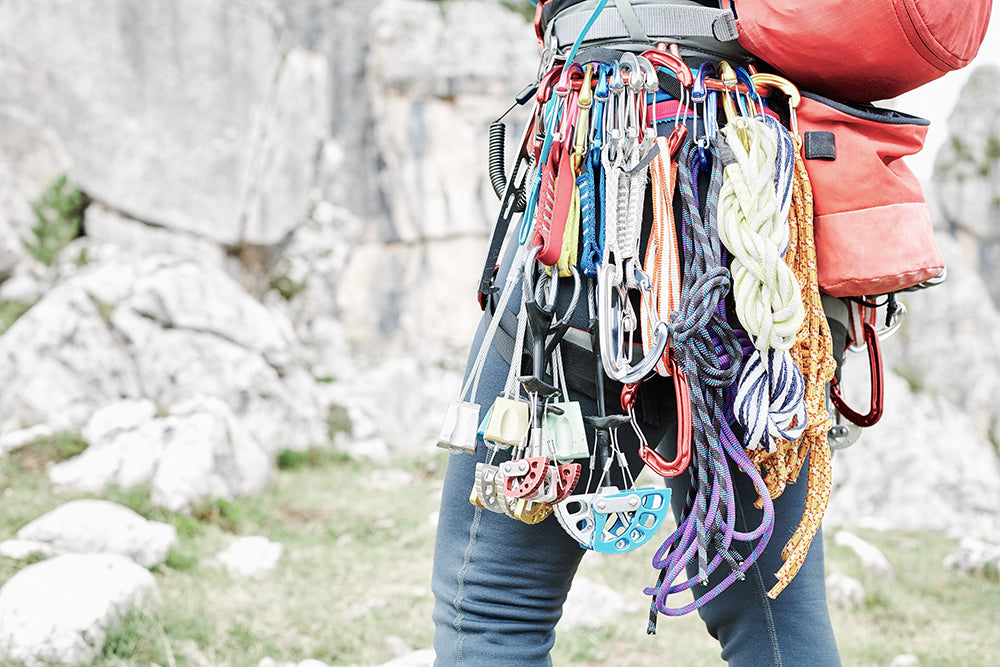
1. Climbing Gear
With indoor climbing, you don’t really need much gear. You’ll get by with a harness, chalk bag, shoes, and at most a rope. In many cases, you can even rent all of these at the climbing gym and won’t need to purchase anything at all in order to get started.
When it comes to outdoor climbing, things start to get more complicated. If it’s your first time climbing outdoors, it’s likely you’ll be going with someone that has some experience, so they should have all the gear you need.
Take care when choosing outdoor partners, though.
Remember that your safety will be in their hands. Are they trustworthy and safe? Don’t just tag along based on their gym climbing grades alone.
A great idea is to take a gym to crag class, often provided by your climbing gym. There, you can ask questions and meet other climbers who are either interested in outdoor climbing or more experienced ones who might be willing to climb with you.
Not much can beat having a great mentor, so if the opportunity arises where you have the partnership of a climber much more experienced than you, treasure that relationship.
Another great way to learn about what exactly is involved in climbing outdoors is to hire a guide. They'll take you out for a day of climbing and make sure you're safe the whole day through.
If you want to start making outdoor climbing a regular thing, you’ll eventually have to start buying some gear. Your own shoes, chalk bag, crash pad, rope, nuts, cams, slings, and quickdraws are just a few things you’ll have to consider.
Different styles of climbing will require different sets of gear, and we’ll get to that later in this article.
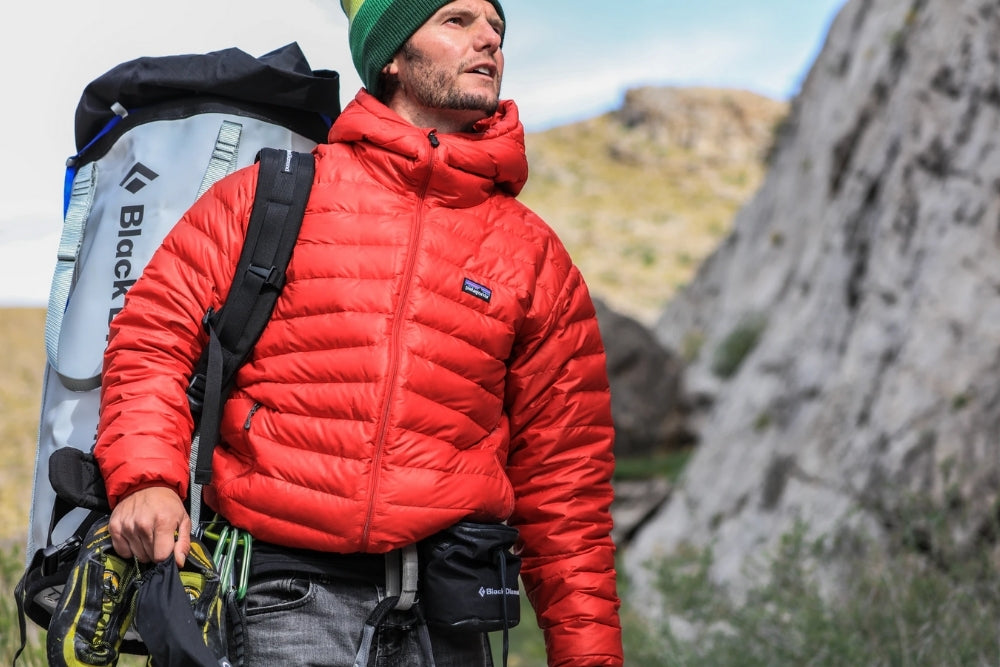
2. Approaching The Climb
There isn’t much of an approach when you go climbing indoors. Most of the time, it’s just a matter of of parking your car and walking into the gym. On a really difficult evening, you might have to park a few blocks away and walk through a storm to get to the front doors.
Climbing outdoors is kind of like that. Turned up to eleven.
First, you have to find a parking lot, which is often easier said than done. Once you’re parked, you may have to walk anywhere from 100 ft to dozens of miles into the backcountry with with anywhere from 15-50+ lbs of equipment to find the crag. You'll also have to adjust for weather and change your plans at the drop of a hat if the weather turns for the worse.
And that’s just the start of it!
Once you’ve found the crag, you need to find the individual routes on the rock face. Guidebooks can sometimes be nearly impossible to decipher — reading them is definitely an acquired skill. Stacking your guidebook with another resource like Mountain Project, or just some local knowledge is a great idea.
Ask other climbers in the area for directions or head to the nearest ranger station first to ask for guidance if you’re new to the area. You can also stop by a nearby gear shop, where the staff will very often fill you in on the local etiquette, weather patterns, and any other helpful tips you might need to know.
Remember to build in extra time in your climbing day for approaches and descents. You don't want to get stuck out in the wilderness because you didn't think about how long it would take to hike to the rocks!
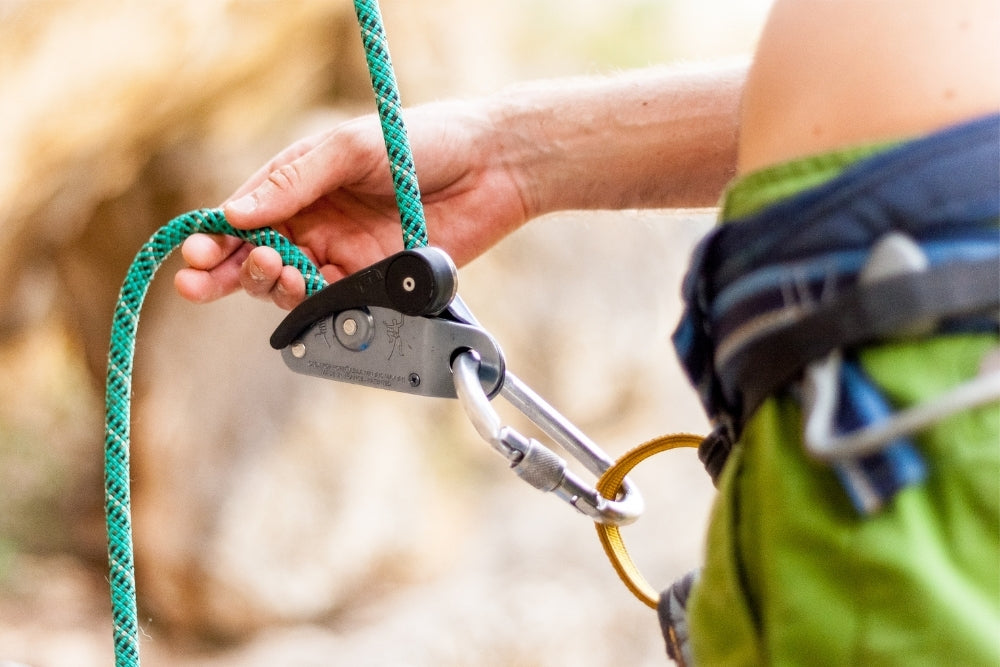
3. Belaying Complexities
Belaying outdoors and indoors doesn’t differ too much when it comes to technique — it’s mainly the additional complexities and the element of danger you have to watch out for when you’re outdoors.
Take a look around you before you start belaying your partner outdoors. Is the ground level? Are there tree branches or rocks you should watch out for? Make sure your partner’s fall zone is safe, and take into account what type of terrain they are climbing.
You don’t want break your partner’s ankles by short-roping them on a slab or not managing the rope properly when they are climbing above a ledge. Basic knowledge of physics and plain old common sense can go a long way here, but nothing beats the wisdom of experience.
Ask a mentor or more experienced (and trusted) climbers for advice on belay techniques. Don’t assume you know everything there is to know about belaying because you aced your gym's lead belay test.
In addition to paying attention to your surroundings, the key to climbing safely outdoors is to pay close attention to your partner. Keep communicating with your partner, so you know exactly what’s going on and what they plan to do.
Especially when cleaning a route, make sure you know whether your partner intends to lower off the anchor or rappel. This is a common mistake that even experienced climbers can make and often leads to tragic accidents and even deaths.
Listen to the Sharp End Podcast for some great documentation of climbing accidents and insights on how to prevent them.
If you’re going to be multi-pitching or will be climbing in a windy area, walkie-talkies can be a great addition to your pack. They’ll enhance your communications with your partner and can make your day easier by reducing stress. You won’t have to yell loudly at each other or try to guess what the other person is shouting.
You should learn some of the common belay phrases and understand what they mean. Take a look at this article before you go.

4. Falling: A different Kind Of Fear
If you’ve been lead climbing indoors for a while, there’s an excellent chance you’ve taken a fall. Luckily, taking a fall indoors is fairly well-protected.
Bolting at the gym tends to be pretty friendly, with no run-outs and not too many awkward clips (if your gym’s route setters are considerate folk).
The floors are often protected with thin padding in the rope climbing areas and thick padding in bouldering areas.
But here’s the thing:
Taking a fall outside is very different. Not only do you have to deal with the exposure of the climb, but there are many other potential dangers you have to watch out for.
Sideway swings, whippers, and inverting are all the things you have to deal with way more often when you’re climbing outside.
And if you’re bouldering, you'll need to be aware of dangerous rocks, bad landings, and gaps between crash pads.
If you’re bouldering outside, make sure you have a spotter with you to assist your falls and be a second set of eyes for you.
Do your best to learn about proper pad placement. Gaps between pads have broken many an ankle.

5. Indoor vs. Outdoor Climbing Grades
Unfortunately, the grading system indoors just doesn’t compare to the grades outside. Just because you can climb a particular grade inside doesn’t been you can do the same grade outside, especially if you’re trad climbing.
Make sure to set realistic expectations if you’re transitioning from gym to crag.
More often than not, trad climbing is just SCARY for gym climbers. The fear can really kick in when you’re fiddling with gear just after the crux and your legs get wobbly and your arms are totally pumped.
If you’re just learning to trad climb outside, make sure you start from grades much lower than your max at the gym and work your way up. Practice your belay skills and how to operate your gear on the ground in a safe environment. It would be ill-advised to go charging up the wall thinking, "I'll figure it out when I get there!"
Bouldering outside can also be really discouraging if you're transitioning from gym to crag. Bouldering is the hardest discipline of climbing when it comes to raw physical power, so go easy on yourself if you’re able to send some pretty hefty grades at the gym but V0’s outdoors have you totally stumped.
This happens to literally everyone, and there's no reason to feel bad about it. Indoor and outdoor grading is just different, so it's best not to compare your indoor personal record to what you can climb outdoors.
Outdoor climbing is unpredictable, and grading is no different! Certain areas have their own grading style, and it takes time to get used to the different types of rock, too.
However, part of the fun of outdoor climbing is the unpredictability, so it's a good idea to start looking forward to it rather than fearing it. If you can learn safe practices all around, you'll develop excellent judgement which will help you avoid injury and climb your best for as long as possible.
Outdoor Climbing Disciplines
You know how your climbing gym has a bouldering section and a rope climbing section? Outdoor climbing has different "sections," or discplines, too! There are many more ways to climb outside than at your local gym.
In this section, you’ll get a brief understanding of the most common disciplines of outdoor climbing and what you need for the job. The disciplines are listed here from the least amount of gear needed to the most.
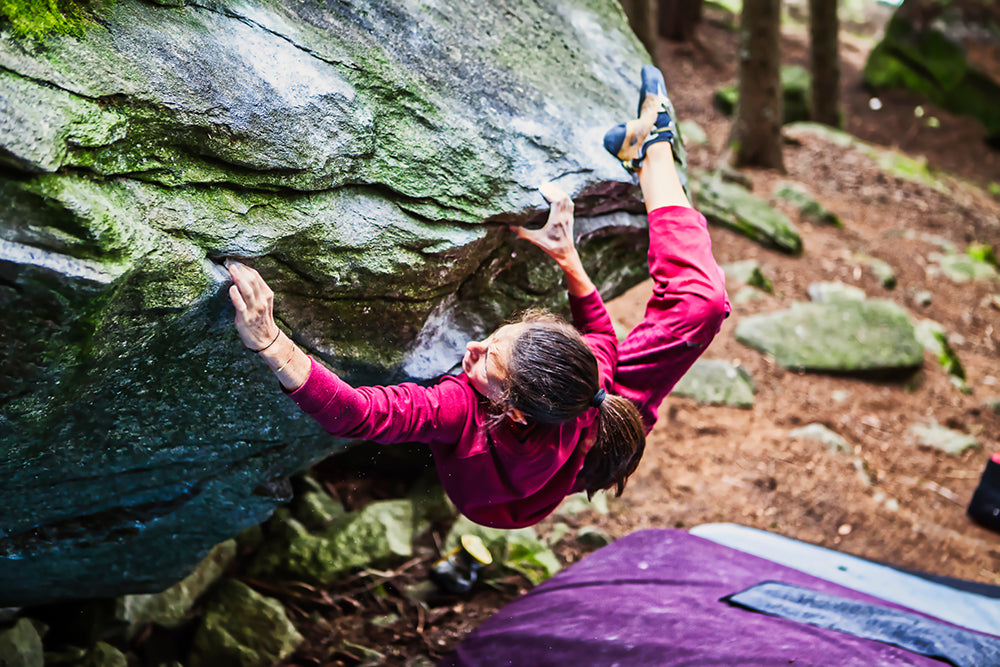
Bouldering
Bouldering outdoors is pretty similar to bouldering at the gym, movement-wise. The difference is that you’ll probably be climbing at elevation without climate control.
To boulder outside, you’ll need a portable crash pad to protect yourself from falls. Most crash pads can be folded in half and carried like a large backpack.
Most climbers who started indoors will start their outdoor climbing journey by bouldering, because it's easy to get by with just your shoes and a chalk bag. If your friends have their own crash pads, it's generally no problem at all for them to bring you along even if you don't have one of your own.
Some boulder problems will require multiple pads or at least a spotter to move the pad as you climb. Traverses (climbs that move sideways) are a great example of this.
Bouldering is relatively social as a climbing discipline, and rightly so. One benefit of climbing with friends is having an abundance of crash pads around. The safer you can make your landings, the harder you’ll be willing to try.
Do yourself a favor and spot your friends while they are having a go on the boulder. They'll do the same for you, and you'll cultivate a healthy practice within your group of watching out for each other and making sure everyone is having a good time outside.
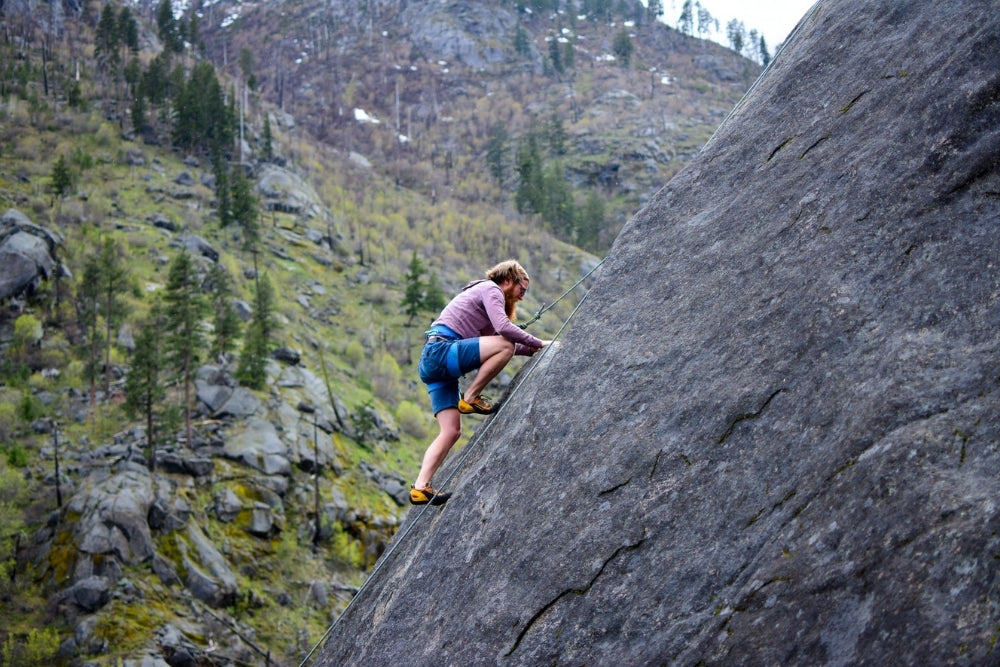
Top Roping
If you’re a newcomer to outdoor climbing, top-roping is a great way to get started. It brings a little bit of that safe and secure feeling of gym climbing to the outdoors.
It also works well for climbs where you can’t place gear due to poor rock conditions or difficult terrain.
The idea is to set up an anchor at the top of the wall to feed the rope through. The climber will tie in to one end of the rope, and the belayer to the other. You can use a pre-existing anchor that’s already securely bolted to the wall, or set up your own anchor using traditional climbing gear.
Make sure you know how to build a safe anchor before setting up a top rope for others! And vice-versa, make sure the person who is building your top rope anchor knows what they are doing.
If you want to learn how to build safe anchors, a great book to read is Climbing Anchors by John Long.
To top-rope climb outdoors, all you need are your shoes, harness, and chalk (optional). Of course, this is assuming you have someone to set up the top-rope for you!
Just for laughs, check out this Top Rope Tough Guys video for a classic, hilarious take on "extreme" top-roping.
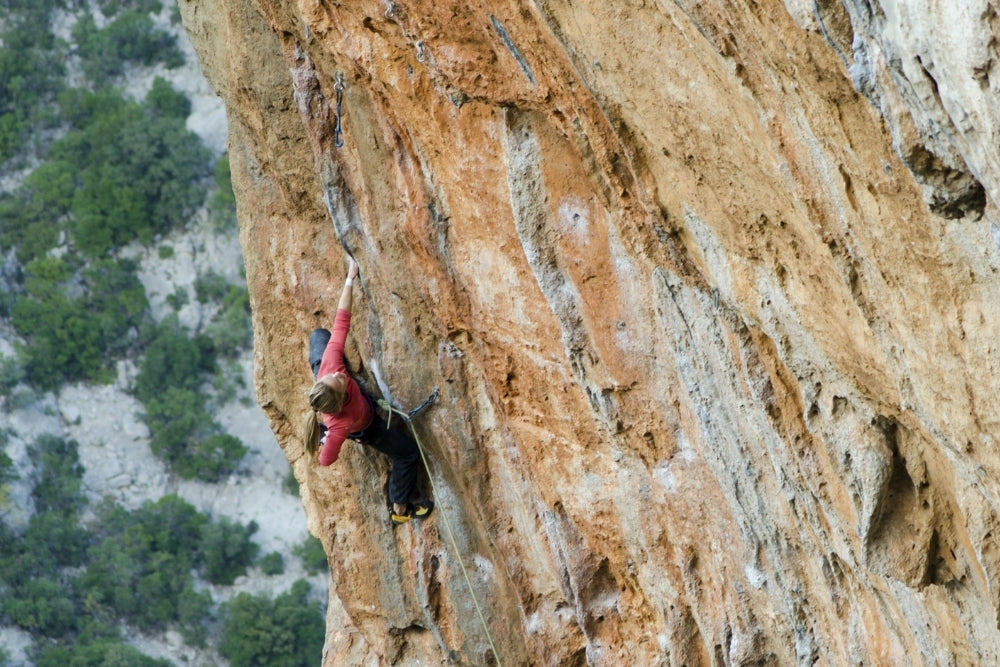
Sport Climbing
Many climbing gyms have sport climbing areas. It’s the style of climbing where you clip your rope into bolts using quickdraws.
Because you are lead climbing (with your rope on the ground as opposed to starting with the rope pulling you from the top), it can be significantly scarier than top-rope climbing. However, it won't be as complex as trad climbing, since you won't have to be placing your own gear into the rock. Instead, you'll be clipping your own quickdraws into bolts that are already secured to the rock.
That said, you shouldn’t blindly trust sport climbing bolts, either. Make sure to check if they are in good condition and well maintained before assuming they are okay to hang your life on.
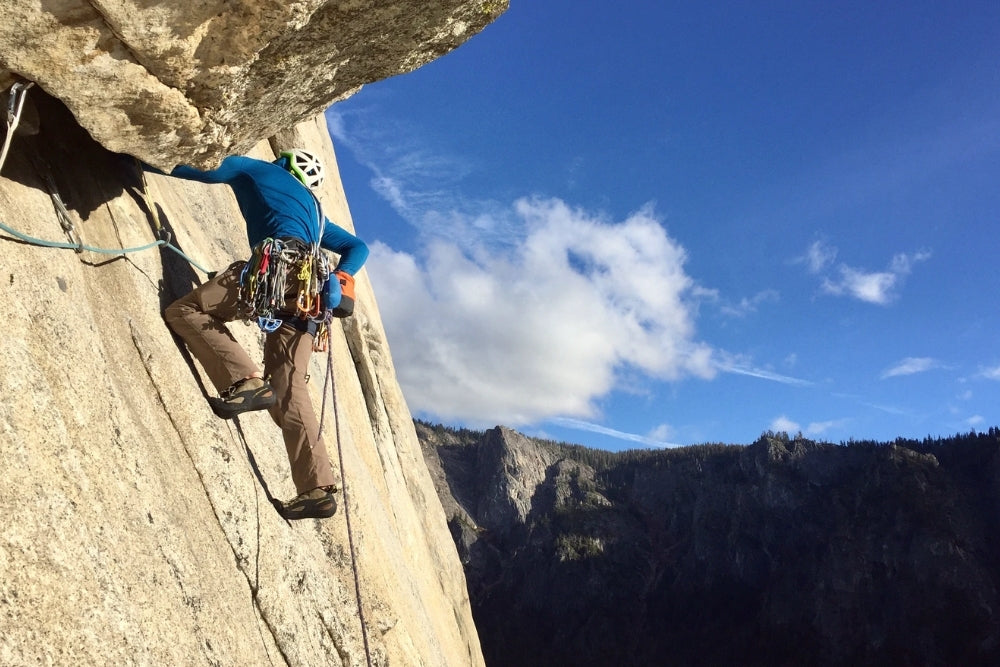
Traditional (Trad) Climbing
This is a style of climbing where the climber places gear in the wall (nuts, cams, tricams, etc) as they climb up. The climber will be lead climbing, and the belayer will be feeding the rope out of the belay instead of pulling it taught like when top roping.
Once the lead climber has built their anchors and has either pulled up the rest of the rope or lowered back down to the ground, the second climber will take the gear out as they climb. This is commonly called "cleaning."
A nut tool can really come in handy when trying to remove tricky pieces of gear that are stuck or have walked. If you’re willing to work for it, you might even end up with a little booty! (Gear that other parties have left behind).
Trad climbing provides more significant risks as gear can fail if incorrectly placed or if you're not familiar with the physics of how a fall can affect your system.
This style of climbing requires a lot of gear and can be pretty costly to get into. Once you’re invested in a solid rack, however, a whole new world of possibilities can open up for you.
There are many climbing areas that are for trad climbing only, and many multipitches and alpine ascents can only be accessed when you have a trad rack.
There are many trad climbing purists out there, and once you get started, it's really hard not to love the little oddities and complexities of trad climbing.
Before moving on to the next section, it’s worth noting there are other outdoor climbing methods like free soloing, aid climbing, and big wall climbing. But they are pretty advanced and probably not the usual place to start for gym climbers just getting introduced to outdoor climbing.

A Simple Guide to Outdoor Climbing Etiquette
Outdoor climbing has a code of conduct, and you should respect it if you want to keep climbing outdoors.
This is where simply being a considerate human being really pays off, and your ability to communicate with other people in the climbing area will come in handy.
"Leave it better than you found it" may sound clichè, but it's a code we simply must follow. If we trash our recreational spaces, we do our future selves no favors.
Again, simple common sense can get you far when it comes to outdoors ethics. In addition to using your noggin, there are some guidelines you should be aware of.
Here are a few points that you should know about before heading out to the crag:
- Dispose of your waste correctly
- Stay on established trails
- Be aware of local ethics like wet rock protocol
- Clean up chalk marks
- Don’t play music
- Respect others
- Keep a low profile - don't travel in huge groups
- Park and camp in designated areas
For a more comprehensive list, head over to the Access Fund's Climber's Pact to read more about how you can be a great example outdoors, and to sign the pact to make our crags safer and better for all. Leave No Trace is another fantastic resource for how to exist a little more ethically outside.
Follow these guidelines to win the hearts of your fellow outdoor climbers and enjoy a lifetime of epic outdoor adventures wherever you may go.
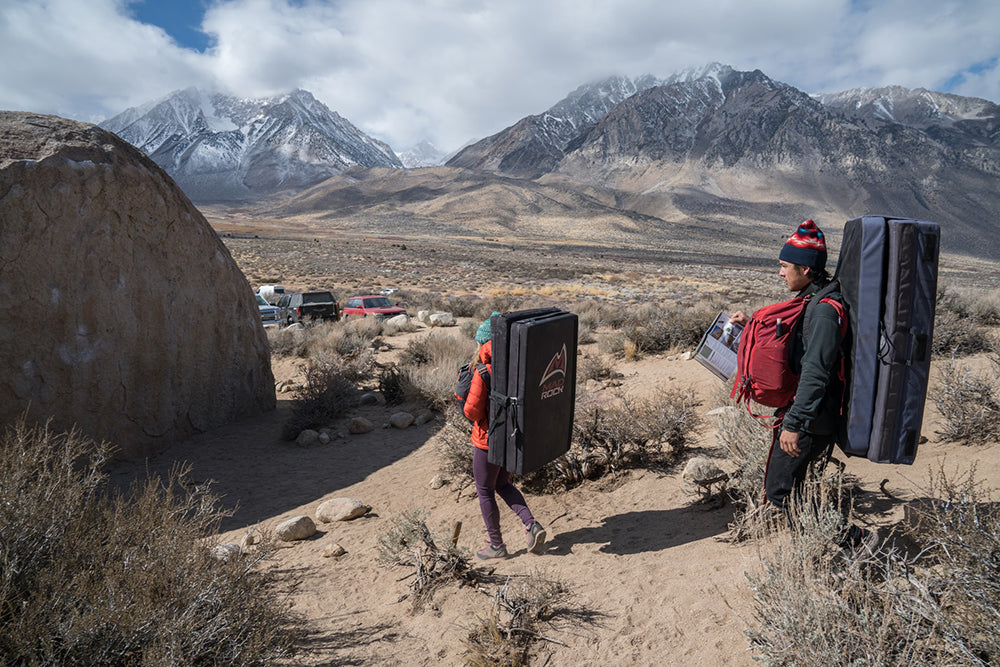
Ready to hit the road?
Let us know how it goes! If you found this article helpful, drop us a comment so we know to keep writing simple guides for climbers like this one.
If you're loking for a great rock climbing shirt to wear on your next adventure, we recommend these:
Leave a comment
Comments will be approved before showing up.
Also in News

The Climbing Training Struggles You Can’t Ignore (And How to Overcome Them)
March 19, 2025 6 min read
Read More
Building Trust and Teamwork: Qualities of a Great Climbing Partner
February 12, 2025 4 min read
Read More Recent Articles
- The Climbing Training Struggles You Can’t Ignore (And How to Overcome Them) March 19, 2025
- Building Trust and Teamwork: Qualities of a Great Climbing Partner February 12, 2025
- Climber Story: Bex Ballow January 29, 2025
- 9 Climbing Resolutions for 2025 December 31, 2024
- Climber Story: Kanani Kalahiki December 11, 2024
- 12 Awesome Gift Ideas for Climbers in 2024 November 20, 2024
- Climber Story: Nick Ranelli November 06, 2024
- If climbing was a scary movie, this would be the title... October 30, 2024
- Climber Story: Britney Berkstresser October 02, 2024
- The best (and worst) names for climbing routes we've ever seen September 25, 2024
Subscribe
Sign up to get the latest on sales, new releases and more …
want 15% off?
Get a welcome gift when you sign up with us!

